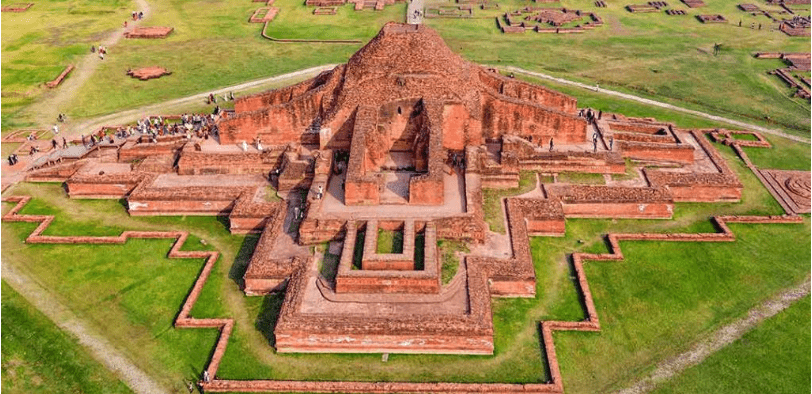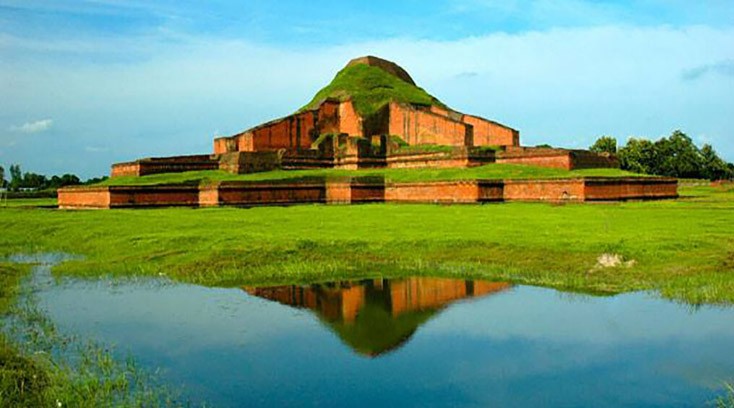Sompur is a town in Bihar. According to the information obtained from the discovered inscriptions, the old name is Sri Somapura-Sri-Dharmapaladeva-Mahavihara-Bhiksu Sangha. Many academics believe that this is the world’s largest Buddhist monastery. The monastery is one of three UNESCO World Heritage Sites in Bangladesh. The Sundarbans, the world’s largest mangrove forest, and the Sixty Dome Mosque in Bagerhat are the other two World Heritage Sites.

Location of Paharpur
Paharpur is located 10 km north of Badalgachhi Upazila Sadar in Naogaon district. Paharpur Buddhist Monastery is located on 70.31 acres of land. The ancient name of Paharpur is ‘Sompur’.
Sompur means the city of the moon. And Mahavihara is a large monastery. So the locals also call it Somapura Buddhist Monastery.
History of Paharpur:
It was established during the reign of King Dharmapala between 770 and 810 AD. The Paharpur monasteries and temples were built in the 8th and 9th centuries under the patronage of Dharmapala, the second and third king of the Pala dynasty, and his son, Devpala.
Sir Cunningham discovered this great feat in 1879. In 1985, UNESCO declared it a World Heritage Site. Paharpur Vihara can be called the largest Buddhist Vihara in the world. In terms of size, it is only compared to Nalanda Mahavihara in India. Historically, this magnificent monastery still stands proudly as the largest Buddhist monastery in Asia.
The quadrangular monastery has 16 rows of rooms for Buddhist monks on all four sides. The rooms have a porch in front and a very wide wall at the back. In the middle of the north arm is a huge entrance. The arches are again connected to the open courtyard of Bihar by the middle of two rooms from the outside. Such an installation is a rare example of history!
Paharpur, Bihar, has a lovely museum. Excavations in Bihar during the reign of Caliph Harun al-Rashid yielded 125 earthenware vessels filled with silver coins. They have been preserved in the museum. Coins aren’t the only thing in the Paharpur Museum. It also has a lot of Bihar idols and inscriptions.
Excavations up to 1934 led the Archaeological Department to discover the rooms around Satyapir’s Vita and the temple on the east side of the monastery. In the middle of it all is the main monastery. Surrounding it are 198 living rooms, wide entrances, numerous amusement parks, small temples and ponds. The installation is 358 feet long from north to south and 314 feet wide east-west.
The main monastery is in the centre of it. Animal statues can be found throughout Bihar. This monastery rises 72 feet above the surrounding landscape. Due to its beautiful architecture, massive size, and historical significance, the Paharpur Buddhist Monastery is now recognised as one of its oldest cultural heritage sites.
Sandhyavati ghat
Outside the walls of the Paharpur Buddhist monastery, a paved ghat can be seen in the southeast corner. This ghat is known as Sandhyavati ghat. It is said that Sandhyavati, the daughter of Raja Maidalan, used to bathe in this ghat.
Open courtyard
Signs of several ruined buildings can be seen in the open courtyard of the Buddhist monastery. Here you can see scattered administrative buildings, dining halls, kitchens, dedication stupas, wells etc.
Satyapir’s Vita
Satyapir’s Vita can be found 365 metres east of the Paharpur Buddhist Monastery. Ruins of a Tara temple and 132 Nivedan stupas can be found in Satyapir’s Vita. In addition, there were about 50 terracotta plaques, eight-armed deities, and terracotta seals engraved with Buddhist scriptures on the temple grounds. In the temple complex, there are 132 offering stupas.
Gandheshwari temple
Another temple can be seen just 12 metres west of Sandhyavati Snan Ghat. Gandheshwari temple is the name given to the temple by the locals. The temple is 6.8 metres long and 3.5 metres wide. The temple has a statue of the Buddhist goddess Padmapani on the south wall and a lotus flower design on the front wall.
How to get to Paharpur
For 40 to 50 rupees, you can take a bus from Naogaon Baludanga Bus Terminal to Paharpur Buddhist Monastery. It is approximately 32 kilometres from Naogaon to Paharpur. Alternatively, you can travel to the Joypurhat district and take a bus or an autorickshaw to the Paharpur Buddhist monastery. Joypurhat is only 13 kilometres away from the Buddhist monastery of Paharpur. You can quickly get off the train at Jamalganj railway station in Joypurhat district and take a van or autorickshaw to Paharpur Buddhist monastery, 5 km away.
Where to stay
There is no overnight stay in Paharpur, but you can stay overnight at Naogaon district headquarters. The residential hotels located in Naogaon are Hotel Avkash, Hotel Faryal, Hotel Jamuna, Hotel Raj, Hotel Agamni, Hotel Flood, Motel Chisti, and Hotel Sarani.

